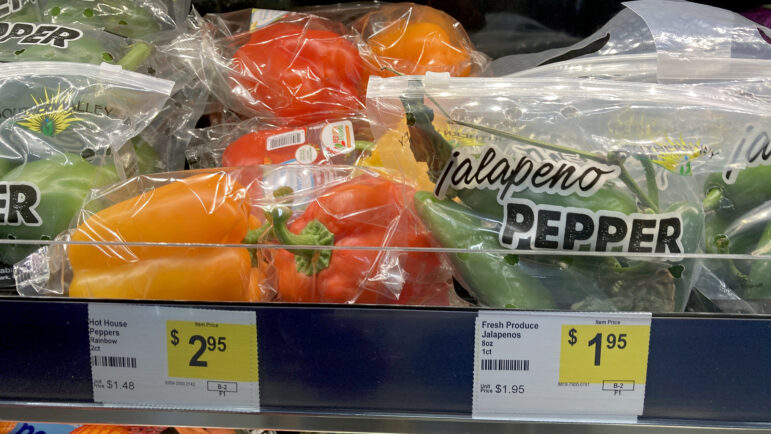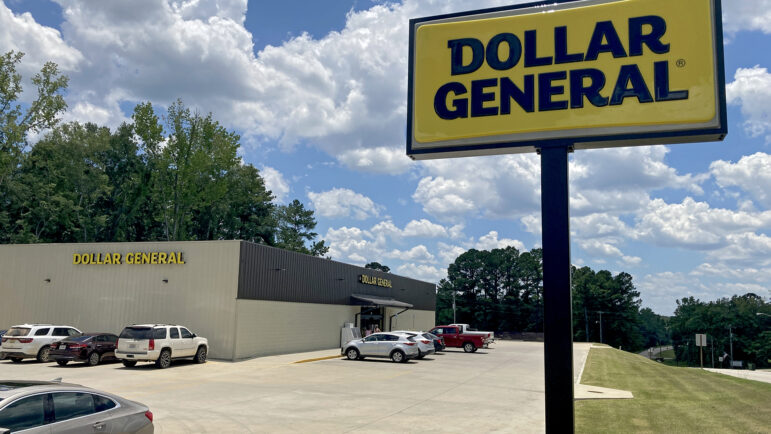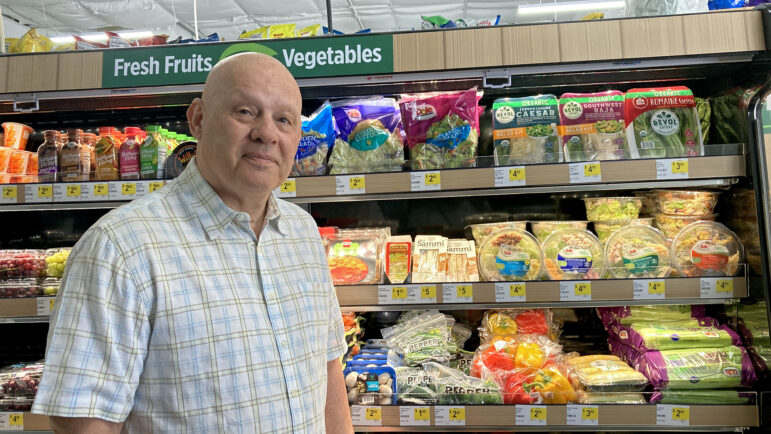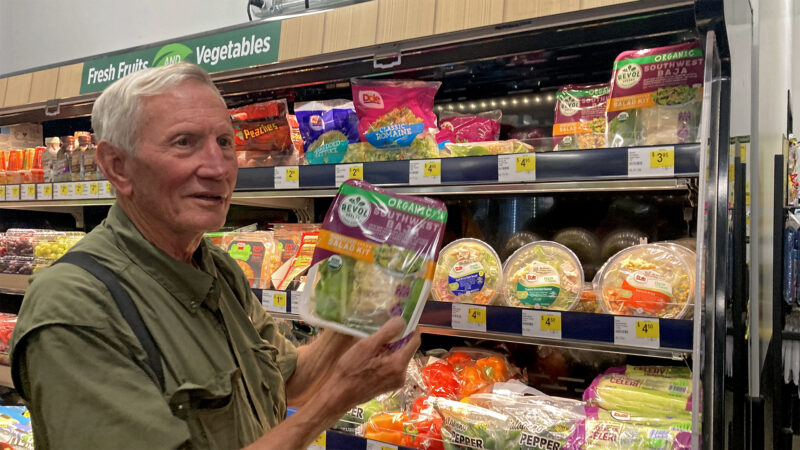Thousands of Dollar General stores now sell fresh produce. Could it improve rural food access?
Richard Petcher picks out a fresh salad kit from the produce aisle of the Dollar General in Fruitdale, Alabama, on June 24, 2024. Petcher said his small unincorporated town is grateful for the produce now offered at the store.
Rural shoppers love dollar stores as the rare, and often only, place in town to buy necessities — ranging from allergy medicine to motor oil.
Now, you can add fresh vegetables to that list.
More than 5,400 Dollar General stores sell fruit and vegetables outside the frozen aisle: onions, apples, lemons, organic salad kits and more line the section’s 16 feet of wall space.
The addition of produce to these stores could transform nutritious food access across the United States, especially in small towns. Most have no other options, and rural grocery stores — with their tight profit margins, especially on produce — have long struggled to stay open in towns with few customers.
But grocery store advocates have long accused dollar stores of worsening food access in rural America, arguing the discount chains’ relentless low-cost prices and business model shutter mom-and-pop grocers.
They worry the extra competition could lead to more rural stores closing shop.
Fresh fruit comes to Fruitdale

Fruitdale, Alabama, is less of a town and more of a scattering of houses around a high school. The unincorporated community holds three churches, one gas station, less than 200 residents and no grocery store.
Despite this, Dollar General added produce to the town’s store last year, swayed by a petition from residents across Washington County.
Richard Petcher, a local farmer, recently picked up breakfast at the store: whole milk for his baby goats and organic greens for himself to enjoy with his omelet.
“If I made a trip to Mobile four days ago, it wouldn’t have been fresh,” Petcher said. “The whole community is very grateful for the Dollar General.”
The discount chain started selling produce at its DG Markets, stores closer in design to a grocer, back in 2003. In 2017, the company tested selling fresh greens at about 100 of its more traditional stores before ramping up its offerings to thousands of locations over the past year.
In January, a press release said Dollar General now has more stores selling fresh produce than any other mass retailer or grocer in the country, beating out both Kroger and Walmart. Those supermarkets have much larger produce sections, but Dollar General strategically offers the top 20 items normally sold at traditional grocery stores.
The discount chain also has a much deeper reach into rural America — and everywhere else with more than 20,000 stores. At last count, the three major dollar brands — Dollar General, Family Dollar and Dollar Tree — have about as many locations as Walmart, McDonalds and Starbucks combined.
‘We need policy solutions’

The Center for Science in the Public Interest has been campaigning for Dollar General to provide healthier options since 2022.
A poll from the organization found that customers generally have a positive view of dollar stores, but want more nutritious shopping choices. Dollar General officials have heard the same from customers, which is why the company started its produce expansion.
This earned the chain applause from senior policy associate Karen Gardner, but she worries about the company’s long-term commitment to offering fresh vegetables.
“I think both, hooray — this is great. And, we need policy solutions,” Gardner said.
After all, Dollar General hires few workers without offering many hours, often causing stores to be manned by just one employee at a time. Meanwhile, produce requires more attention than canned goods and much of it needs to be thrown away when it spoils. It’s a large reason grocery store margins are so low while Dollar General’s decade-long growth spurt has been fueled by keeping costs down and profits high.
Dollar General said it’s relying on artificial intelligence to improve orders for stores, but did not say whether the produce line has been profitable and would not comment on operations, including whether it would provide more hours for workers in stores with spoilables.
Rural grocers worry about growing competition

Gardner believes communities should consider passing their own laws about dollar stores.
Dozens of cities already have limits on how close the chains can open near each other, while some require a certain amount of produce to be sold.
Many of these laws were passed to protect grocery stores, but the actual research on how much of a threat dollar stores pose to grocers remains mixed. Dollar General officials contend their stores are a supplement rather than competition.
Rural grocery store owners, however, say they’ve already seen how much the discount chains hurt their business.
When a Dollar General near a Cahoy’s General Store, a full-service grocery in South Dakota, temporarily shut down due to a flooded parking lot, sales at Cahoy’s went up 30%.
The store’s owner, Dan Cahoy, now expects his produce sales to take a hit with Dollar General offering its own. He also believes that in some places, this could lead to food access growing worse.
“Especially for other small towns that their grocery store might be struggling,” Cahoy said. “It could end up closing some stores down.”
Grocers at Kansas State University’s Rural Grocery Summit said they give more back to their community than corporations like Dollar General — from sponsoring little league teams to recirculating more money in the local economy while hiring more workers.
Duane Legg, owner of Legacy Food Markets and Bakery in West Virginia, said it’s also hard for grocers to compete with the purchasing power of big chains and special deals they get from large corporations.
“How do you compete as a mom-and-pop?” Legg asked.
For Legg, the answer has been through his bakery and locally sourced products shoppers can’t find at a dollar store. Other grocers said they’ve survived by going a similar route — stepping up, working harder, offering healthier options and specialty goods.
That’s why Harold Crouch, mayor of Chatom, Alabama, is not worried about the Dollar General in his town threatening the lone grocery store.
“Without competition, quality sometimes and price sometimes falls by the wayside,” Crouch said. “This just helps both of them become better.”
This story was produced by the Gulf States Newsroom, a collaboration between Mississippi Public Broadcasting, WBHM in Alabama, WWNO and WRKF in Louisiana and NPR.
Viral global TikToks: A twist on soccer, Tanzania’s Charlie Chaplin, hope in Gaza
TikToks are everywhere (well, except countries like Australia and India, where they've been banned.) We talk to the creators of some of the year's most popular reels from the Global South.
This painting is missing. Do you have it?
An important work from a rediscovered artist has been absent from public view since the 1970s. A New York curator is hunting for it.
Memory loss: As AI gobbles up chips, prices for devices may rise
Demand for memory chips currently exceeds supply and there's very little chance of that changing any time soon. More chips for AI means less available for other products such as computers and phones and that could drive up those prices too.
Brigitte Bardot, sex goddess of cinema, has died
Legendary screen siren and animal rights activist Brigitte Bardot has died at age 91. The alluring former model starred in numerous movies, often playing the highly sexualized love interest.
For Ukrainians, a nuclear missile museum is a bitter reminder of what the country gave up
The Museum of Strategic Missile Forces tells the story of how Ukraine dismantled its nuclear weapons arsenal after independence in 1991. Today many Ukrainians believe that decision to give up nukes was a mistake.
Jeffrey R. Holland, next in line to lead Church of Jesus Christ of Latter-day Saints, dies at 85
Jeffrey R. Holland led the Quorum of the Twelve Apostles, a key governing body. He was next in line to become the church's president.









